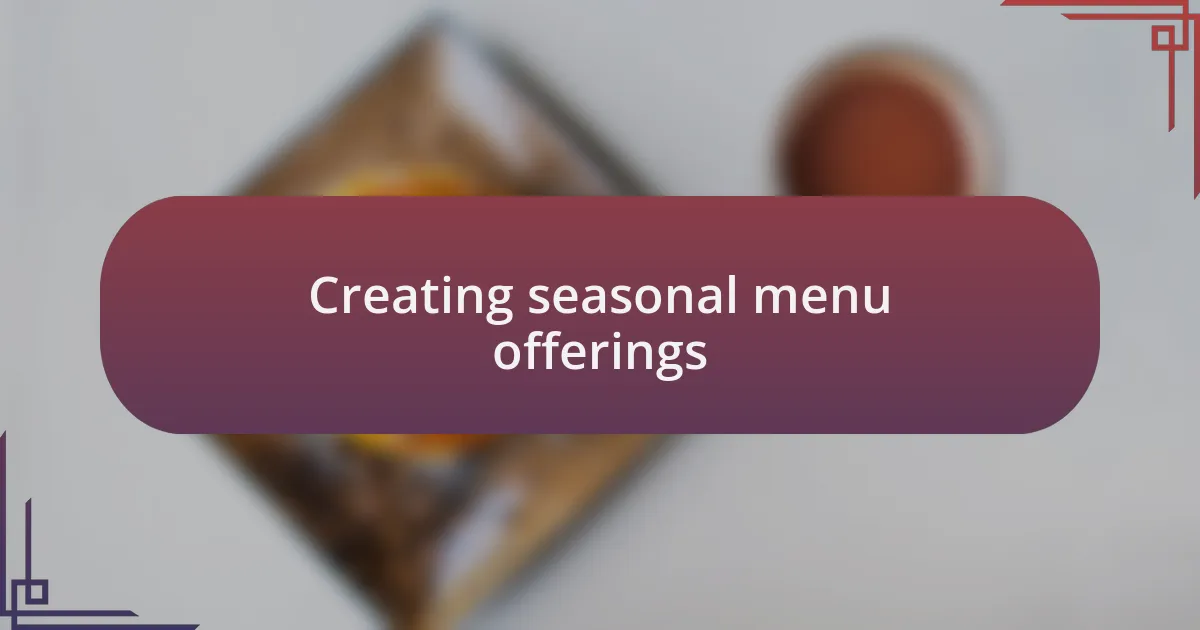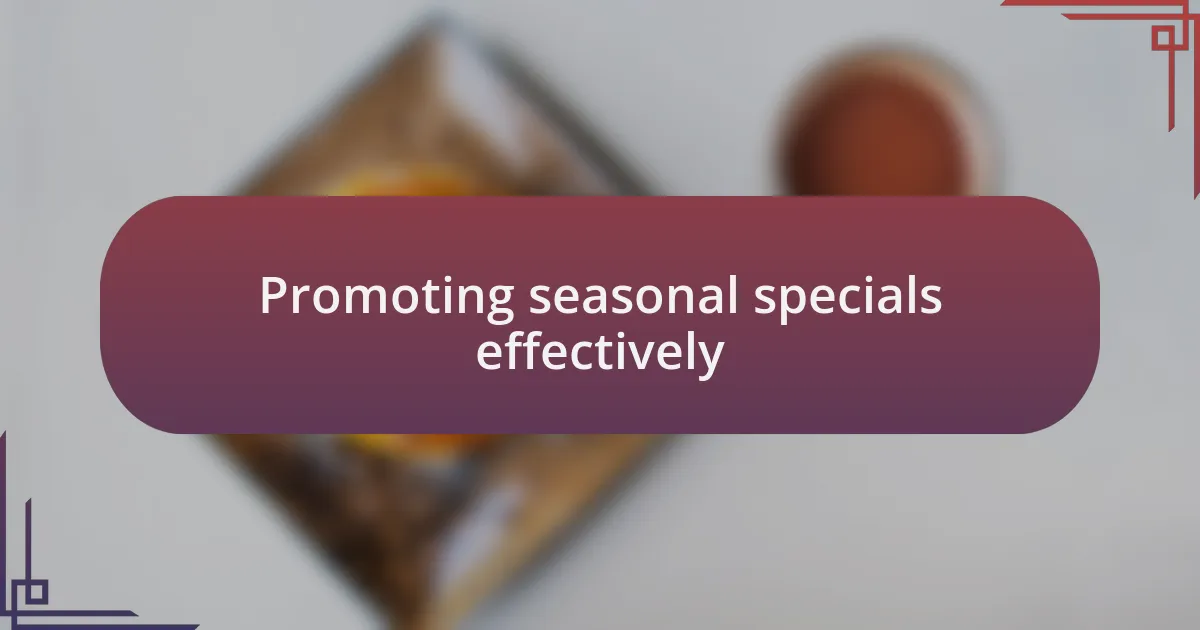Key takeaways:
- Understanding seasonal sales strategies can significantly boost customer engagement and sales by aligning menu offerings with seasonal cravings and emotional connections.
- Identifying seasonal food trends through customer feedback and social media insights helps tailor menu items, enhancing customer satisfaction and sales.
- Promoting seasonal specials through creative marketing, personalized emails, and events fosters community engagement and excitement around new offerings.
- Adjusting pricing strategies, such as bundling and dynamic pricing, can optimize revenue during peak seasons while meeting customer demand.

Understanding seasonal sales strategies
Understanding seasonal sales strategies involves recognizing the unique opportunities each season presents. For instance, I recall a winter season when I introduced cozy takeout packages that paired comfort food like soups and stews with discounts. This not only boosted my sales but also provided customers with warm meal options during the chilly months.
Have you ever considered how the mood of your customers changes with the seasons? In summer, people crave light and refreshing meals, whereas winter often drives them to hearty, warm foods. By adapting your menu and promotions to align with these seasonal cravings, you can create an emotional connection and ultimately encourage repeat business.
Timing is essential in implementing seasonal strategies. I’ve learned that launching promotions, like a romantic dinner special for Valentine’s Day, can significantly increase orders. It’s about anticipating customer needs and creating an experience that resonates with them during specific times of the year. How might your offerings change throughout the seasons to reflect the emotions tied to holidays and weather?

Identifying seasonal trends for food
Identifying seasonal trends for food starts with observing customer behavior and preferences throughout the year. I remember noticing that sales for spicy dishes surged in the cold months, likely because people wanted something to warm them up. By tracking these patterns, I can tailor my menu to offer more of what customers desire when the weather shifts.
One interesting aspect I’ve encountered is how holidays influence eating habits. For example, around Halloween, I introduced themed treats that resonated with the festive spirit. It was a small change, but customers loved it, and it reminded me how aligning food choices with seasonal events can spark excitement and boost sales. What trends have you seen in your own business during various holidays or seasonal changes?
To truly pinpoint these trends, I recommend leveraging social media insights and customer feedback. I often engage with my audience by asking what their favorite seasonal dishes are, and the responses guide my future offerings. This interactive approach not only helps refine my menu but also fosters a community, making customers feel valued. Have you tried reaching out to your clientele to understand their seasonal cravings better?

Creating seasonal menu offerings
Creating seasonal menu offerings is a fantastic way to not only diversify your menu but also to connect with your audience emotionally. I recall a winter when I introduced warm, hearty soups made with seasonal vegetables, and customers responded enthusiastically. It struck me how a simple bowl of soup could evoke feelings of comfort and nostalgia, particularly during the colder months. Isn’t it amazing how food can create such connections?
In my experience, presenting new items that reflect seasonal changes often brings a wave of excitement. Last summer, I crafted a refreshing fruit salad featuring local berries and mint. The feedback was immediate and overwhelmingly positive, with customers sharing their experiences on social media. This kind of engagement not only drove sales but also fostered a sense of community around those seasonal offerings. Have you ever thought about how seasonal items could become a conversation starter among your customers?
Don’t forget to consider local ingredients when creating these offerings. Sourcing produce that’s in season not only enhances the flavors but also supports local farmers. I once collaborated with a nearby farm to feature their fresh tomatoes in a summer pasta dish, which became a best-seller. It resonated with customers who appreciated the taste and the story behind the meal. What local ingredients can you incorporate to make your seasonal offerings even more special?

Promoting seasonal specials effectively
To effectively promote seasonal specials, creative marketing strategies play a crucial role. I remember a time when I showcased a pumpkin spice latte during fall by using bright visuals on social media. The response was incredible; people loved seeing the cozy imagery and the enticing descriptions. Have you thought about how powerful visuals can be in making your seasonal items irresistible?
Using email campaigns to highlight seasonal offers is another tactic I’ve found to be particularly effective. I once sent out a targeted newsletter featuring a winter special, highlighting its ingredients and the story behind it. The personal touch resonated with my audience, increasing both engagement and sales significantly. How often do you connect with your customers through personalized emails to keep them excited about what’s coming next?
Another approach I recommend is organizing events around your seasonal offerings. Last spring, I hosted a tasting night for new dishes and saw a great turnout. The lively atmosphere, combined with the chance for customers to try new flavors, turned out to be a fantastic way to increase interest. Have you considered hosting events to deepen the connection between your seasonal menu and your community?

Optimizing pricing for seasonal demands
When it comes to optimizing pricing for seasonal demands, I’ve learned that understanding market trends is essential. For instance, during the summer, I adjusted my prices for refreshing cold dishes based on demand spikes. It felt rewarding to see how a slight increase in my pricing reflected the popularity of seasonal items and still brought in sales. Have you explored how adjusting your prices in real-time can influence your revenue?
Another strategy I’ve found effective is bundling seasonal items at a special price. Last autumn, I created a combo that paired a hearty soup with a seasonal bread, offering it at a discount. Not only did it encourage customers to try more of my dishes, but it also created an enticing offer that felt like a deal. Have you considered how bundling might resonate with your customers during peak seasons?
Dynamic pricing has also been a game-changer for my seasonal sales. I remember a holiday season where I implemented flexible pricing based on demand trends—lowering prices during slow periods and increasing them when demand surged. The results were impressive, and I was able to maximize my profit margins while keeping customers happy. Have you thought about how adopting a dynamic pricing strategy could enhance your approach to seasonal offerings?

Leveraging customer feedback for improvements
Gathering and implementing customer feedback has been pivotal in refining my takeaway food offerings. I recall a time when several customers mentioned that they desired more vegetarian options. Instead of dismissing their comments, I took it to heart and tested a few new recipes. The response was overwhelmingly positive, transforming those initial suggestions into popular menu items. Have you considered how customer insights could directly shape your offerings?
Utilizing feedback forms or quick surveys after the meal is something I now prioritize. I noticed that even a simple request for feedback via email yielded valuable insights about portion sizes and pricing. By making small adjustments in response to this information, like slightly increasing portion sizes for certain popular dishes, I was able to enhance customer satisfaction. What steps are you taking to make sure your customers feel heard?
Most recently, I started hosting a quarterly tasting event to solicit direct feedback on new ideas and concepts. Seeing customers interact with each other and share their opinions sparked creativity in my menu development. One dish that I initially hesitated to introduce ended up being a crowd favorite after I closely listened to the attendees’ reactions. How often are you engaging with your customers to tap into their preferences?